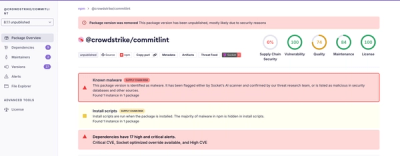
Research
Malicious fezbox npm Package Steals Browser Passwords from Cookies via Innovative QR Code Steganographic Technique
A malicious package uses a QR code as steganography in an innovative technique.
i18next-react-postprocessor
Advanced tools
embed React elements inside your i18next translation strings
embed React elements inside your i18next translation strings
because sometimes you just want to dump some JSX into your l10n'd text and don't want to be bothered with the whole react-i18next dog-and-pony show.
$ npm install --save i18next-react-postprocessor
import the package in the usual way, and use a new instance of the exported class as i18next middleware:
import i18next from 'i18next';
import ReactPostprocessor from 'i18next-react-postprocessor';
i18next
.use(new ReactPostprocessor())
.init();
then when it's time to render translated strings, make sure you set the postProcess option to 'reactPostprocessor':
import i18next from 'i18next';
import React from 'react';
function MyComponent(props) {
return (
<div>
{i18next.t(`myKey`, {
postProcess: `reactPostprocessor`
})}
</div>
);
}
or, if you're using it in more than just a few places, it might be worth adding to i18next's init options instead:
i18next
.use(new ReactPostprocessor())
.init({
postProcess: [ `reactPostprocessor` ]
});
// now you don't need to specify "postProcess: 'reactPostprocessor'" when calling i18next.t
the postprocessor by default looks for tokens delimited by <angleyBrackets> to perform interpolation of React elements:
i18next
.use(new ReactPostprocessor())
.init({
lng: `en`,
postProcess: [ `reactPostprocessor` ],
resources: {
en: {
translation: {
myKey: `just <clickHere> to do the things`
}
},
fr: {
translation: {
myKey: `<clickHere> et voila`
}
}
}
});
element interpolation is done just like regular ol' string interpolation:
render() {
return (
<div>
{i18next.t(`myKey`, {
clickHere: ( <img onClick={() => console.log(`click!`)} src="pug.jpg" /> )
})}
</div>
);
}
const middleware = new ReactPostprocessor({
keepUnknownVariables: Boolean
prefix: String
suffix: String
});
all fields are optional.
keepUnknownVariables controls whether or not to preserve any interpolation tokens which aren't present in the options passed to i18next.t; it defaults to false (meaning tokens with no corresponding value are replaced with the empty string). prefix and suffix define the beginning and end of the interpolation token to look for; they default to '<' and '>' respectively.
$ git clone https://www.github.com/orzechowskid/i18next-react-postprocessor
$ npm install
[ edit edit edit... ]
$ npm run example
$ open http://localhost:8808
[ verify verify verify... ]
$ npm run build
a full test suite is located in src/_tests_ . npm run test should run jest --verbose --coverage.
MIT
FAQs
embed React elements inside your i18next translation strings
The npm package i18next-react-postprocessor receives a total of 6,251 weekly downloads. As such, i18next-react-postprocessor popularity was classified as popular.
We found that i18next-react-postprocessor demonstrated a not healthy version release cadence and project activity because the last version was released a year ago. It has 1 open source maintainer collaborating on the project.
Did you know?

Socket for GitHub automatically highlights issues in each pull request and monitors the health of all your open source dependencies. Discover the contents of your packages and block harmful activity before you install or update your dependencies.

Research
A malicious package uses a QR code as steganography in an innovative technique.

Research
/Security News
Socket identified 80 fake candidates targeting engineering roles, including suspected North Korean operators, exposing the new reality of hiring as a security function.

Application Security
/Research
/Security News
Socket detected multiple compromised CrowdStrike npm packages, continuing the "Shai-Hulud" supply chain attack that has now impacted nearly 500 packages.